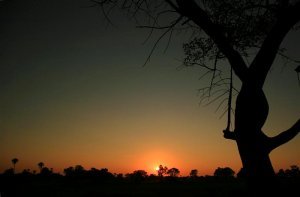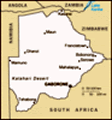Advertisement
Published: April 20th 2008

 Sunrise over the Okavango
Sunrise over the Okavango
When I'm on holiday, I prefer not to be up at 06h00. However, in this instance, the rewards far outweighed the results of staying in bed. The sunrise was spectacular!I didn’t sleep last night. I know that because I heard every marula fruit within a hundred yards of me leaving the trees and landing on the corrugated iron roofs. I also know that the genets were having a talent show and the local troupe had donned their clogs and were dancing up and down the roof of my lodge to Offenbach’s famous Can-Can. I just wasn’t sure why they’d chosen last night for their revue; Tennessee Williams’ Cat on a Hot Tin Roof would have been more appropriate and at least my sleepless night would have been worth the irony.
And now, it was still dark and the alarm was reminding me that we’d agreed to be up at 06h00 in order to view the early morning animals. To be totally honest, I really didn’t want to go out and count zebra; I’d much rather remain tucked up counting sheep.
Still, shuffling over to the other side of my lodge, I completed my ablutions, smeared myself in deodorant and pulled down my walking boots from the top shelf where I’d left them. I’d moved everything off the floor just in case any undesirable living being decided to make

 Sunrise in the Okavango
Sunrise in the Okavango
It was 06h30 and we were already afloat on one of the most unstable craft imaginable. The experience though was priceless.a home in what I was about to wear.
After getting dressed in the dark, I grabbed my trusty hat (which was becoming more and more tattered) and my camera gear and set off down the steps. The smell of paraffin greeted me as I reached the ground and walked past the flaming torch that had recently burned itself to death.
Keeping an eye out for grey pachyderms in the grey pre-twilight bushes, I made my way along the sandy paths to the main lodge. Right on time, at 06h30, I climbed the steps to find that my fellow travellers had already scoffed some sesame seed, flapjack-esque offering and were halfway through a jug of coffee and pot of tea. Not to be outdone, I too asked for a pot of coffee from Maid Miriam and made a start on the snack. We were due for a 3 hour walk and breakfast proper was not until 11h00!
Camera to the ready, I recorded the stirrings of sunrise, grabbed my hat and bag and trooped off to the waiting mekoro. The silence was deafening as we glided through the papyrus and across the water-lily carpeted lakes. On reaching

 Vlad the Impala
Vlad the Impala
What's the difference between an Impala and a Springbok? Not a joke, but a serious question! I've studied all my photos and can categorically confirm that I have captured no Springbok. How do I know? The Springbok has "Go-faster Stripes"!open water, Poison stopped and stood listening just to ensure that we were not going to have our day ruined by an encounter with an amorous hippo. On convincing himself that there would be no blind date, he bit his pole deep into the mud and propelled his mokoro across the open water. Colin followed.
Although Poison’s boat was longer and possibly more difficult to manoeuvre, I was intrigued by the difference in our polers’ styles. Poison would steer as clean a path as possible through the water, avoiding clumps of water-lily and taking corners rather neatly. Colin, on the other hand, in a shorter mokoro would cut corners, preferring to steer a route through the papyrus rather than stay in clear water. I had a preference for Poison’s style of piloting but I had a preference for my shorter mokoro; it wasn’t sinking!
Sitting at water level, it wasn’t easy to see where water ended and drier land began. It was therefore with some surprise that, with one final gargantuan pole, Colin shot the mokoro bow-first onto the grass. A short walk was required up a little sand bank into the shade of a palm tree and

 Follow the Herd (of Impala)
Follow the Herd (of Impala)
This beautiful sight was captured in the early morning sun. The Impala were rather alert as something was bothering them. We never found out what is was, but over the next three hours, various animals were sighted in a nervous disposition. We suspected a lion although never saw one.there, in front of us, was the early morning panorama that was to be our home for the next few hours.
101 Things to do Before Breakfast
We set off through the tall grass with Poison leading the way. Brian was next, keeping an eye out for birds with Jill closely behind. I followed a short distance behind Jill and then, right at the back, carrying a small blue freezer box, was Colin with the all important cold drinks. Colin was also the smallest and therefore the most likely prey for any marauding lions!
Our little party snaked its way through the tall grass heading for a line of trees in the distance. Poison’s keen eye and sharp hearing was invaluable as he would spot animals long before we could see them. Even when he pointed them out to us, we still couldn’t see them!
This morning however, was different. We all saw the impala at the same time. Mind you, it wasn’t all that difficult as they bounced across our line of sight! Something had spooked them and I don’t think it was my laundry as we were up-wind. Something, however, had put the wind-up.

 The Graceful Impala
The Graceful Impala
This truly graceful young male was a delight to watch as he bounded across the scrub, easily clearing 9 feet with each leap. Small bushes didn't seem to get in the way - with one bound ...Continuing on our way, we passed numerous sculptures built by those incredible little insects, the termites. Apparently, after 5 years of hard work, these little workers will build a mound the size of a football. It therefore seemed that some of these mounds had taken tens of years to build. The minarets towered above the surrounding scrub, each forming a spiral, designed to keep the egg chamber below ground at a constant temperature. The termites tend to build in the shade and so work on the opposite side of the mound to the sun, as it arcs across the subtropical sky, hence producing a spiral.
Suddenly, we caught sight of the impala again. The herd had now settled down and the big male was doing his best to ensure that his harem was all present and correct. He stood and watched us before checking on his ladies before returning to cast an eye over us. We managed to get surprisingly close before pressing on into the clear morning air.
A little later, we saw lion paw marks in the sand but no other signs of the elusive cat. Close by was another group of impala, all males this

 Saddle-Billed Stork
Saddle-Billed Stork
When standing, this bird needs 5 feet of clearance. When flying, it's more like 9. Rather amusingly, this black-legged bird has pink knees - Spike Milligan would have been proud!time. This bachelor herd appeared to be shadowing the harem, with any particularly opportunistic male occasionally attempting to usurp the top position in the opposing herd. Apparently, the defeated male would return to the bachelor herd although I wasn’t clear whether it would start at the bottom and have to work its way up the hierarchy.
All around us, the starlings were chattering and the turtle-doves coaxing us in their calls to “look HARder, look HARder”. Above us, a saddle-billed stork flew over the trees whilst a little group of pyjama-clad horses decided on what to take for breakfast.
By this time, the sun had risen enough to put some heat into the early morning. So, finding a little termite mound, we broke open the supplies and quenched our collective thirst on cold water. Suddenly, ever observant Jill pointed out a solitary baboon, sitting in a tree. Not to be outdone, Poison pointed out the other 15-20! There, ahead of us, was a large troupe and we appeared to have disturbed them. Amongst the troupe was a sprightly little youngster who delighted in running up and down the tree trunk and hiding behind its mother when it had

 Zebra
Zebra
I never tired of finding zebra. These are the Plains Zebra - I just love their Black and White Punk-like mane!got bored of the sight of us.
Along came the dominant male and herded the group ahead of us through the grass. As we watched, they became agitated and started chattering and looking to our left. Without warning, a group of impala sprang into centre-stage and off into the wings. The baboons followed, leaving the dominant male to ensure the stragglers were paying attention. Another smaller group of impala entered stage-left, bounced their way across the orchestra pit and disappeared off right. No idea what it was that caused the stir, but judging by the low mumblings, the elephants weren’t too happy either!
With the sun getting ever more adventurous, we made our way back to the mekoro and returned to the lodge for breakfast.
Real Africa
It was only 11h00 when the mekoro met with the lodge. Climbing the steps, we were greeted by Maid Miriam and a delightful breakfast. Filling my plate with fruit, nuts and cereal, I ordered a coffee and a couple of fried eggs before settling into my seat overlooking the Delta. Satisfied by my eggs, bacon, mushrooms, beans and onions, I retired to my lodge to freshen up.
Returning to

 Lilac Breasted Roller
Lilac Breasted Roller
This bird-on-a-stick is literally a bird on a stick. The Lilac Breasted Roller perches rather blatantly at the tops of trees, poles or other high vantage points from where it spots insects, lizards, scorpions, snails, frogs, small birds and rodents moving about on the ground.the main lodge, I donned my hat and sat on the veranda taking in the late morning sun. The baboons were in camp but didn’t dare venture into the main lodge. They did have a habit of taking the toilet paper though! I spent the next hour or so reading some of the copious books off the shelves, making the most of my
Out of Africa experience. All the time, hippo were out in the Delta, making their presence heard and one was even to be seen on the shore of the island opposite, forging a path to the water.
Despite a recent full breakfast, lunch was served at 14h30. After the delightful repast and suitably sated by a bottle of fine red wine, we persuaded Poison to escort us to his village. So, armed with a couple of stout sticks and three chairs, we set off through the back of the camp towards the other side of the island.
This wasn’t on the tourist trail and it was interesting to see the workings of the camp. Passing past the laundry and workshops, we ventured onto open scrub, heading for a distant line of trees. After about 30

 Dragonfly
Dragonfly
Not a particularly brightly coloured dragonfly, but some bird somewhere considers it a tasty morsel!minutes, we reached the water’s edge. In front of us were not the traditional mekoro, but the modern plastic version. These seemed to be a little taller and curve in more at the top. As we found out, they were also very unstable and I was convinced on numerous occasions that I was going to get very wet. On the positive side, they didn’t leak.
Reaching the far bank, Poison led us up a path to the first of a number of houses. Construction was interesting, to say the least. The houses were circular with reed roofs incorporating a small hole to let out the smoke from an internal fire. The walls were built of bottles or tin cans and mud. Interestingly, I didn’t see a house build of bottles
and tins cans! Even more surprising, the mud was not just any mud. No, the best mud was to be found from the termite mounds and the little industrious workers were responsible for providing the building material for all the huts. Each year, the rains would wash a little of the mud away and each year the occupants would reapply a layer to replace that which was lost. Ingenious.

 Martial Eagle
Martial Eagle
We were delighted to have seen this eagle, simply because it's not particularly common. Although it will take stork (but not butter!), it prefers francolins and young baboons - of which there were plenty in the vicinity.Of the forty or so houses in the village, almost all were built in this fashion. Poison proudly showed us his house; one of the first we’d encountered. His little garden was supporting a small crop of corn, which, if I’m totally honest, didn’t look too healthy. However, he informed us that the biggest problem was not the water (which was obtained from the river) but the elephants. Poison had solved the problem in his garden by growing very hot chillies, the smell of which was not to the elephants’ liking.
Working our way through the village, I shook hands in the African fashion with an elderly gentleman who was sitting in the shade listening to a radio. We exchanged small talk and continued on our way. Stopping at the headman’s house, we received a formal welcome and permission to remain. Meanwhile, all around us, women and children were scampering around carrying blankets full of woven trinkets. Reaching a clearing, they spread their wares on the ground and waited for us to peruse. My Australian friends were unable to purchase anything, due to the strict quarantine laws of their country and I still had no rucksack. However, I

 Baby Baboon
Baby Baboon
This little chap was very inquisitive. It kept running round its mother, trying to see what we were up to and occasionally running up the tree for a better view. With eagles in the area, the baboons were always on watch.did purchase some bracelets from one young lady, who rather shyly took my money when I commented upon her colourful attire.
Bidding our thanks and farewells, we returned to our mekoro and the rather tortuous journey back to Chief’s Island. I have to confess that I really wasn’t looking forward to the trip and my fears were borne out by the fact that the journey back was just as unstable and the outward trip. I have never been so eager for a journey to end as I was that evening.
Upon reaching dry land, we retraced our path and, upon reaching the outskirts of camp, Poison directed us to a little tree house. Instructing us to climb and wait, he headed off with Colin, returning some minutes later with Maid Miriam, some drinks and a silver platter containing onion rings and a very nice chilli dip.
Settling down, we enjoyed rings of onion encased in a hot red sauce watching the hot red sun dip its ring below the tree line, bringing another spectacular sunset down on another spectacular day.
Advertisement
Tot: 0.209s; Tpl: 0.021s; cc: 14; qc: 84; dbt: 0.1225s; 1; m:domysql w:travelblog (10.17.0.13); sld: 1;
; mem: 1.3mb






















